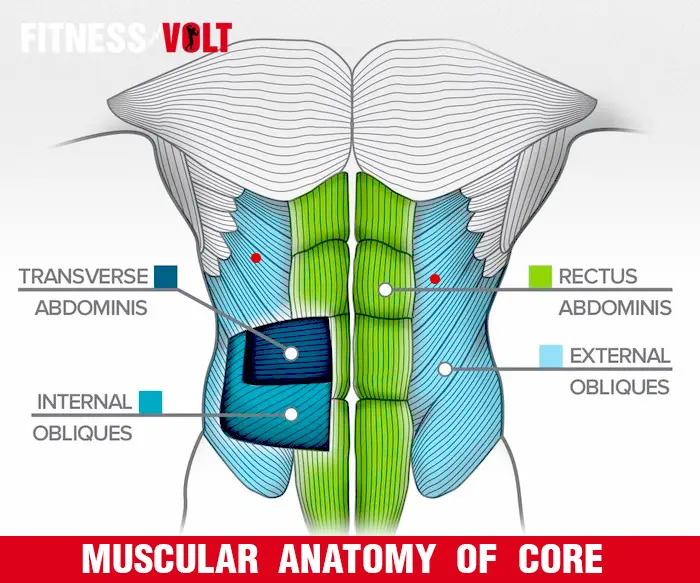Let’s get one thing straight from the outset; you can’t spot reduce fat from your abs – or any other body part for that matter. That’s not how your body works. Doing set after set of crunches will not magically melt fat from your abdomen, allowing your six-pack to shine through.
Instead, you need to train and eat to lose fat from all over your body; that’s the best way to develop a defined midsection. That said, targeted abs training can make your midsection muscles more prominent. To do that, you need to overload your abs, literally bullying them into growth.
One of the best ways to train your abs is circuit training.
Circuit training involves doing several exercises back to back with little or no rest in between. Training this way raises your heart and breathing rate, which will increase your calorie expenditure, leading to faster fat loss. As an extra benefit, circuit training is also very time efficient.
This tried-and-tested abs circuit hits your midsection from multiple angles to ensure that you develop all-around core strength and conditioning.
Level Up Your Fitness: Join our 💪 strong community in Fitness Volt Newsletter. Get daily inspiration, expert-backed workouts, nutrition tips, the latest in strength sports, and the support you need to reach your goals. Subscribe for free!
Abs Circuit Workout
This is a circuit workout. Move quickly from one exercise to the next, resting only as long as it takes you to transition to the next movement. Do as many reps as you can in the allotted time. Rest one minute between laps and repeat 2-4 more times. Each circuit should take four minutes.
If 40 seconds is too long, feel free to reduce the work intervals to 30 or even 20 seconds per exercise. You can also rest a little longer between laps if necessary.
Do this workout 2-3 times a week on non-consecutive days to allow time for rest and recovery.
| Exercise | Time | |
| 1 | Stability ball dumbbell crunch | 40 seconds |
| 2 | Leg raise and heel push | 40 seconds |
| 3 | Saxon side bend | 40 seconds |
| 4 | 45-degree back extension | 40 seconds |
| 5 | Stability ball Russian twist | 40 seconds |
| 6 | V-up | 40 seconds |
Ab Circuit Exercises:
Get the most from your abs circuit workout by doing all the exercises with the best possible technique.
1. Stability Ball Dumbbell Crunch
Most people quickly find that regular crunches aren’t all that challenging. That’s why they end up doing sets of 30-50 reps. As well as being a waste of time, high-rep sets aren’t great for building more muscular, harder abs.
Doing crunches on a stability ball means you’ll have to work through a larger range of motion, while the addition of a dumbbell allows you to overload your abs more effectively.
How to do it:
- Sit on your stability ball with your legs bent and feet flat on the floor. Hold a dumbbell or weight plate to your chest.
- Walk your feet forward and lean back until the ball sits in the natural curve of your lumbar spine. Anchor your feet if necessary. Your shoulders, hips, and knees should form a straight line.
- Brace your abs, and lift your head, chest, and shoulders up to form a C-shape with your spine. Crunch your abs, and don’t sit up using your hips.
- Lie back down, extending your spine slightly, and repeat.
2. Leg Raise and Heel Push
Where crunches involve curling your upper body upward, this exercise is all about lifting your legs. While there is no such thing as upper and lower abs – it’s all one muscle – the leg raise and heel push does emphasize the lower fibers of your rectus abdominus.
How to do it:
- Lie flat on the floor with your legs straight, arms by your sides. Brace your abs. Push your lower back into the floor.
- Raise your legs until they are vertical.
- Push your heels up toward the ceiling, lifting your butt and lower back off the floor.
- Lower your hips down and then lower your legs until they are a few inches off the floor.
- That’s one rep – keep going!
3. Saxon Side Bend
Named after old-school strongman Arthur Saxon, this oblique exercise works both sides of your waist at the same time. Raising your arms above your head creates a long lever, so you won’t need a lot of weight to make this exercise effective.
Do it with a barbell, dumbbells, kettlebells, or a medicine ball. Alternatively, you may get enough of a workout with just your arms.
How to do it:
- Raise and hold your weight overhead. Stand with your feet about shoulder-width apart, knees slightly bent for balance. Brace your abs.
- Without twisting your hips or shoulders, lean over to the left and then to the right. Lean as far as your flexibility allows.
- Continue for the prescribed duration
4. 45-Degree Back Extension
This exercise has two purposes. Firstly, it gives your anterior abs muscles a break so you can put more into the final two movements. Secondly, it strengthens your lower back so that your midsection is strong not just at the front and sides but from the back too.
How to do it:
- Climb onboard the machine so your hips are resting against the leg pad. Bend your knees slightly and place your hands behind your lower back (easiest), across your chest (harder), on behind your head (hardest).
- Hinge from your hips and lean forward as far as you can without rounding your lower back.
- Lift your upper body back up until your shoulders, hips, and knees form a straight line.
- You can also do this exercise using a stability ball instead of a 45-degree bench.
5. Stability Ball Russian Twist
Russian twists are an effective oblique exercise, but this stability ball variation is even better. As well as working your waist, this movement will help mobilize your spine and increase general core stability too. You can do this exercise with a dumbbell or medicine ball, but you may only need to use your body weight at first.
How to do it:
- Holding your weight in your hands, sit on your stability ball. Walk your feet forward and lean back until only your head and shoulders are resting on the ball.
- Extend your arms, so they’re vertical. Brace your abs. Your knees, hips, and shoulders shoulder form a straight line.
- Roll as far as you can to your left without twisting your hips or dropping your shoulders, and then return to the center. Roll to the right and repeat.
6. V-Up
Your final exercise is a demanding abs exercise that combines sit-ups with leg raises. Just grit your teeth, double down, and get it done!
How to do it:
- Lie on your back with your legs straight and arms extended above your head. Your feet should be a few inches off the floor, knees pressed together.
- Contract your abs and lift your legs and upper body simultaneously, reaching up toward your toes. At this point in the exercise, you should be balancing on your butt and lower back.
- Lower your arms and legs and repeat.
- If this is too challenging, bend your knees and do in and outs
Abs Anatomy 101
Level Up Your Fitness: Join our 💪 strong community in Fitness Volt Newsletter. Get daily inspiration, expert-backed workouts, nutrition tips, the latest in strength sports, and the support you need to reach your goals. Subscribe for free!
When most people talk about their abs, they usually mean the muscle at the front of their stomach; the rectus abdominus. While this muscle IS important, it’s only one of several that makes up your midsection. If you want abs you can be proud of, you really need to work the other muscles in this region. They are:
Rectus abdominis
Usually just called the abs for short, this long, flat muscle runs from your sternum and lower ribs down to the bottom of your pelvis. Its functions are flexion and lateral flexion of your spine and compression of your abdominal contents. The sections of your abs are separated by bands of ligamentous tissue, which is what gives the abs their six-pack appearance.
Internal and external obliques
The internal and external obliques run diagonally across your midsection and are responsible for rotating and laterally flexing your spine. The internal obliques lie beneath the external obliques. Both obliques work together and are basically your waist muscles.
Transverse abdominis
Where the rectus abdominis runs vertically up the front of your stomach, the transverse abdominis encircles it like a muscular weightlifting belt. Situated beneath the other muscles, the TVA contracts inward to stabilize your spine.
Erector spinae
While the erector spinae is NOT an abdominal muscle, it’s still important. Basically the muscles of your lower back, working it will ensure your midsection is strong in all directions. Also, the erector spinae holds your torso upright against the pull of gravity, giving you better posture. Standing up tall instead of hunching over instantly flattens your abs.
Training and Nutrition Tips for Six-Pack Abs
As good as our abs circuit is, it won’t do much for you if you don’t combine it with a balanced workout plan and healthy diet. Use the following tips to help you sculpt the midsection of your dreams.
Training
Train your entire body and not just your abs – your abs make up a small percentage of your total muscle mass. It’s highly improbable you’ll be able to develop your abs fully if you don’t train the rest of your body too. Combine this abs circuit with exercises for the rest of your body. You can follow a split routine or do full-body workouts as preferred.
Do your cardio – if your body fat levels are high, you’ll never see your abs. While your diet is important, you can also burn off some of those unwanted pounds with cardio. 2-3 cardio workouts per week should suffice, and you can choose between high-intensity interval training and low-intensity steady state.
Make your abs workouts progressive – the reason we’ve used a time-controlled circuit to train your abs is that it provides plenty of opportunity for progression. When you first do the workout, you’ll probably find that you can’t keep going for the entire 40 seconds per exercise.
But, as your abs conditioning improves, you should be able to do more reps. When you can rep out for the full 40 seconds, it’s time to a) increase the duration to 50 seconds per exercise or b) move onto a more demanding workout.
Either way, to keep your abs getting stronger, you MUST make your workout progressive, striving to work a little harder from one week to the next. You should also apply this principle to all your other workouts – both cardio and strength training.
Nutrition
Create a calorie deficit – fat is stored energy. The only way to force your body to burn that fat is to reduce your calorie intake and increase your calorie expenditure to create an energy deficit. Faced with this shortfall, your body will burn stored fat to make up the difference.
Use our calorie deficit calculator to determine how much you should eat to shed those unwanted pounds of fat. Then use a food tracking app to make hitting your nutritional goals much more manageable.
Eat clean – while you could lose weight eating junk food, it’s generally not a good idea. That’s because things like candy, pizza, and soda are very high in calories, so you won’t be able to eat much despite ingesting plenty of calories.
In contrast, natural foods are usually lower in calories, so you can eat more of them, which means you’ll feel fuller.
Hunger can be hard to resist, so it makes sense to build your meals around the most filling foods. Protein, healthy fats, and fiber are all excellent natural appetite suppressants. In contrast, sugar and refined carbs tend to stimulate the hunger centers of your brain, leading to overeating.
Don’t forget to reverse diet – so you’ve ditched the excess weight and revealed your abs. Well done! Don’t blow it all by going back to your old diet. If you do, there is a real chance that you’ll regain all the fat you just worked so hard to lose, and your abs will vanish again.
Use a reverse diet to gradually increase your food intake without undoing all your progress. Yes, this means you’ll be dieting for a few more weeks, but it also means you won’t have to start over when you realize you can no longer see your abs.
Wrapping Up
A lot of people make the mistake of training their abs every day. After all, if one workout is good, more must be better, right? But, would you train your biceps or legs every day?
Probably not.
There is no reason to train your abs differently from any other muscle group. That means hitting them hard 2-3 times a week to allow plenty of time for rest and recovery. After all, it’s between workouts that your muscles grow and get stronger.
This circuit has been designed to work your abs from multiple angles and develop your midsection from front to back and side to side. However, if you want to see your hard work, you’ll also need to pay attention to your diet and the rest of your training.
Use the information in this article to sculpt the midsection of your dreams and strip off that unwanted fat to reveal your abs in all their glory!












